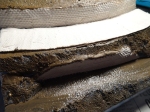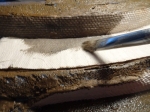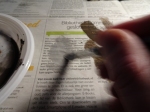 Happy hobbying at home!
Happy hobbying at home!
We were building a little scenery. Once the clay is dry we can start painting our scenery. All areas that will be overgrown with grass and plants is painted dark brown. You can use all sorts of hobby paint as long as it is water based. The foam board does not really like other types of paint. The walls and street will be painted in two layers. First I apply a base colour on the surface. Mixing black, white and some brown will give a nice appearance. It is best to dilute the paint with water.
Then it is important to let the paint dry for a couple of hours. Once the surfaces are dry, we are going to apply a second layer. This time mix the colour in a slightly brighter shade than the base layer (although the opposite is actually also nice to try). This time I use the ‘dry brush’ technic. That means that the paint should not be diluted and you want only a tiny bit of paint on your brush. So first brush any access from your brush on a piece of paper. Once almost all paint is off you can wipe the brush over the top surface of the stones. By this you highlight the raised surfaces. You can repeat the process until you have a nice result.
OK, there is a little dirt road in this scenery. I painted that part with a mix of brown, yellow, black, and white…
to be continued
 Viel Spaß beim Hobby zu Hause!
Viel Spaß beim Hobby zu Hause!
Wir waren unterwegs mit dem Bau einer kleinen Landschaft. Sobald der Ton trocken ist, können wir beginnen, unsere Landschaft zu malen. Alle Bereiche, die mit Gras und Pflanzen bewachsen sind, sind dunkelbraun gestrichen. Sie können alle Arten von Hobbyfarben verwenden, solange diese wasserbasiert sind. Die Schaumplatte mag andere Farbtypen nicht wirklich. Die Wände und die Straße werden in zwei Schichten gestrichen. Zuerst trage ich eine Basisfarbe auf die Oberfläche auf. Das Mischen von Schwarz, Weiß und etwas Braun ergibt ein schönes Aussehen. Am besten verdünnen Sie die Farbe mit Wasser.
Dann ist es wichtig, die Farbe einige Stunden trocknen zu lassen. Sobald die Oberflächen trocken sind, werden wir eine zweite Schicht auftragen. Diesmal mischen Sie die Farbe in einem etwas helleren Farbton als die Basisschicht (obwohl das Ungekehrte eigentlich auch schön ist um mal zu versuchen). Diesmal benutze ich die “Drybrush”-Technik. Das bedeutet, dass die Farbe nicht verdünnt werden sollte und Sie nur ein kleines bisschen Farbe auf Ihrem Pinsel haben möchten. Bürsten Sie also zuerst jeden Übermaß von Ihrem Pinsel auf ein Stück Papier. Sobald fast alle Farbe entfernt ist, können Sie den Pinsel über die Oberseite der Steine streichen. Dadurch hervorheben Sie die erhabenen Flächen. Sie können den Vorgang wiederholen, bis Sie das gewünschte Ergebnis erreichen.
OK, in dieser Landschaft gibt es einen kleinen Feldweg. Ich habe diesen Teil mit einer Mischung aus Braun, Gelb, Schwarz und Weiß bemalt…
wird fortgesetzt
Visit our Construction page | Besuchen Sie unserer Construction-Seite

Niet geschikt voor kinderen onder 14 jaar.
Nicht geeignet für Kinder unter 14 Jahren.
Not suitable for children under the age of 14.
Ne convient pas aux enfants de moins de 14 ans.






